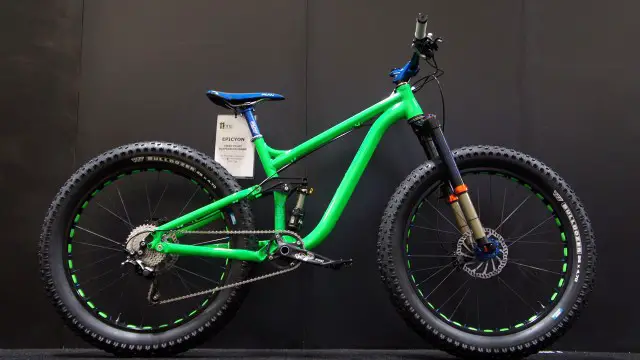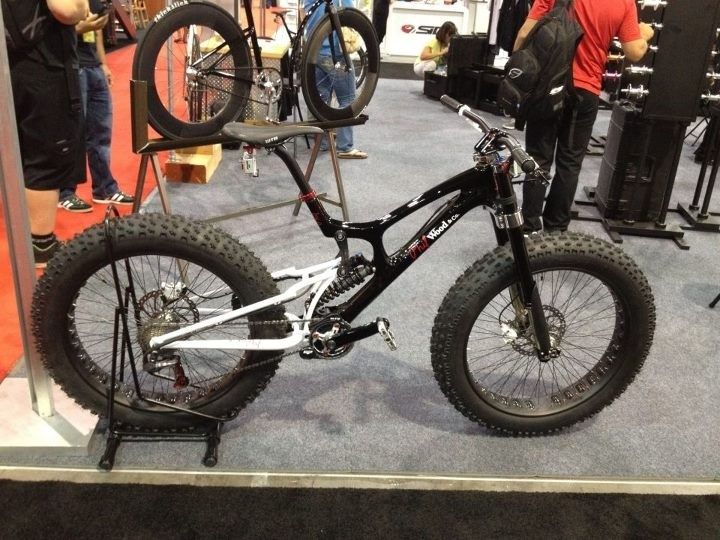You are using an out of date browser. It may not display this or other websites correctly.
You should upgrade or use an alternative browser.
You should upgrade or use an alternative browser.
First Downhill Fatbike
- Thread starter blown240
- Start date

Help Support Rat Rod Bikes Bicycle Forum:
This site may earn a commission from merchant affiliate
links, including eBay, Amazon, and others.
I doubt you will ever find a MTB that comes stock with a ring bigger than a 44. But with the new cassettes that have a huge range, like 10-42, you really only need 1 ring to get almost all the same gear ratios as an older 11-34 cassette. And usually that only needs to be somewhere between 28-36 teeth. Sure you can loose the highest or lowest gear ratio depending on the chainring you choose, but you also loose the weight of 2 rings, the ft derailer, shifter, and cable/housing.
Having a huge gear ratio makes sense if you're drag racing, but there's really no such thing as bike drag racing, at l;east not in an official/organized sense of the term. More realistic ratios take into consideration hills and turns, and the fluctuation of the bike's rate of speed as the rider contends with these things. When you're going offroad, you're dealing with varied surfaces, as well. Fat bikes were designed, really, for sand and/or snow. That throws an even bigger monkey wrench into the idea of a huge top gear. What's a 50x11 going to do for a rider in deep sugar sand?
It's going to slow him down, that's what. It's going to bog the rider down. The same is true for almost any style of riding; truly massive gears provide benefit only for downhills or sprint efforts, and even then, the rider will need the lower ratios in order to remain competitive for any of the situations where the top makes any sense.
In the singlespeed world, ss mtb racers tend to run ratios in the neighborhood of 48 to 55" gears, depending on the course and their riding style (spinner vs masher). Bring a heavier gear on a SS to a mtb race, and you will be left in the dust on any uphills. In the track world, where there are gentle curves but no real hills beyond the banking of the velodrome, it seems like a lot of folks run in the neighborhood of a 92" to 100" gear, going higher for pursuit racing. Realistically, one can only push a truly massive gear for so long. If domination of the velodrome could be had simply by running a bigger gear, competitive track cyclists would obviously run bigger gears. But they don't. 110" is as high as you'll likely see, and that'd tend to be on a pursuit bike.
When you were a kid riding neighborhood races up the block, you would be able to chase down and pass the other kids b/c your BMX ran a 50x16, but if you took your bmx to the track, thst 50x16 would be consistently humbled by the kids running 44x16 (or a similar 52"-55" ratio, achieved with smaller sprockets depending on the era....)
The "right" gearing for any bike is often a compromise between all-out top-end and enough low-end grunt to get you up a hill, or back up to speed from a standstill or after a tight corner/obstacle. When you're pushing around 4" wide tires on 559mm rims in loose conditions, you'll more than likely want to skew that balance more towards the lower end of the spectrum, even on multi-gear set ups.
It's going to slow him down, that's what. It's going to bog the rider down. The same is true for almost any style of riding; truly massive gears provide benefit only for downhills or sprint efforts, and even then, the rider will need the lower ratios in order to remain competitive for any of the situations where the top makes any sense.
In the singlespeed world, ss mtb racers tend to run ratios in the neighborhood of 48 to 55" gears, depending on the course and their riding style (spinner vs masher). Bring a heavier gear on a SS to a mtb race, and you will be left in the dust on any uphills. In the track world, where there are gentle curves but no real hills beyond the banking of the velodrome, it seems like a lot of folks run in the neighborhood of a 92" to 100" gear, going higher for pursuit racing. Realistically, one can only push a truly massive gear for so long. If domination of the velodrome could be had simply by running a bigger gear, competitive track cyclists would obviously run bigger gears. But they don't. 110" is as high as you'll likely see, and that'd tend to be on a pursuit bike.
When you were a kid riding neighborhood races up the block, you would be able to chase down and pass the other kids b/c your BMX ran a 50x16, but if you took your bmx to the track, thst 50x16 would be consistently humbled by the kids running 44x16 (or a similar 52"-55" ratio, achieved with smaller sprockets depending on the era....)
The "right" gearing for any bike is often a compromise between all-out top-end and enough low-end grunt to get you up a hill, or back up to speed from a standstill or after a tight corner/obstacle. When you're pushing around 4" wide tires on 559mm rims in loose conditions, you'll more than likely want to skew that balance more towards the lower end of the spectrum, even on multi-gear set ups.

$19.99
Electra Glide Wall Decal 2ft Long Sport Harley Davidson Bike Motorcylce Sticker Man Cave Garage Boys Room Decor
FatCat Wall Graphics

$249.40
$289.67
Kulana Lakona Tide Adult Beach Cruiser Bike, 26-Inch Wheels, 7-Speed, Silver
Amazon.com























